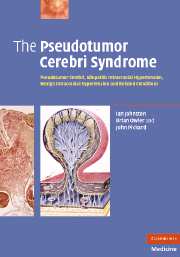 The Pseudotumor Cerebri Syndrome
The Pseudotumor Cerebri Syndrome Published online by Cambridge University Press: 21 August 2009
Introduction
The creation of an experimental model of PTCS would represent a critical step in the understanding of the pathophysiology of this complex condition. Some of the key issues which such a model might help resolve are as follows:
If, as the current evidence seems to suggest, PTCS is primarily a disorder of CSF absorption with a resulting increase in CSF volume as the cause of the intracranial hypertension, where and how is the excess fluid accommodated, and why is there typically no increase in ventricular size?
If, on the other hand, the intracranial hypertension is due to some form of parenchymal oedema, again where precisely is the fluid located, and how do neurological functions, particularly higher functions, remain apparently unaffected?
What is the significance of the elevated cranial venous outflow tract pressure and the often marked proximal to distal pressure gradients within the tract which have been a frequent feature of recent clinical manometric studies. In particular, is the increased venous pressure a cause or consequence of the increase in CSF pressure?
Related to #2 above, how do PTCS patients with marked increases in ICP unaccompanied by commensurate increases in arterial blood pressure tolerate the significant drop in cerebral perfusion pressure with apparent impunity?
Unfortunately, no experimental model has yet been developed, although several of the known aetiological agents such as venous outflow obstruction, vitamin A, steroids and even tetracycline and its derivatives, do suggest themselves as possible agents in attempting to establish a suitable model.
To save this book to your Kindle, first ensure [email protected] is added to your Approved Personal Document E-mail List under your Personal Document Settings on the Manage Your Content and Devices page of your Amazon account. Then enter the ‘name’ part of your Kindle email address below. Find out more about saving to your Kindle.
Note you can select to save to either the @free.kindle.com or @kindle.com variations. ‘@free.kindle.com’ emails are free but can only be saved to your device when it is connected to wi-fi. ‘@kindle.com’ emails can be delivered even when you are not connected to wi-fi, but note that service fees apply.
Find out more about the Kindle Personal Document Service.
To save content items to your account, please confirm that you agree to abide by our usage policies. If this is the first time you use this feature, you will be asked to authorise Cambridge Core to connect with your account. Find out more about saving content to Dropbox.
To save content items to your account, please confirm that you agree to abide by our usage policies. If this is the first time you use this feature, you will be asked to authorise Cambridge Core to connect with your account. Find out more about saving content to Google Drive.